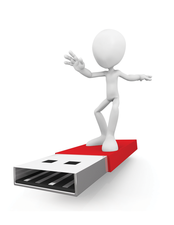Knoppix 7.3 CeBIT Edition
Go Live!

© Lead Image © Michael Novelo, 123RF.com
Knoppix 7.3 comprises the current state of Debian GNU/Linux development and comes with the current hardware support of kernel 3.13, a new update function, and extended security and privacy features.
Keeping a distro current with GNU/Linux development can be quite difficult. Debian's boot system and hardware support via udev can make it difficult for the developer of a Linux distribution to figure out what needs to change just to boot up. Lucky for me, Knoppix's boot system again proved to be a big timesaver. Knoppix completely works around the Debian default startup systems (Upstart/systemd) by using knoppix-autoconfig, a single shell script that does all the work of preconfiguration (Figures 1 and 2). Kernel support for devtmpfs had to be enabled to get the new udev hardware detection and removable device support working again, but the rest of the transition to the Debian testing branch (pre-jessie) went pretty smoothly.
Knoppix on Flash – Now with Update
Many modern netbooks and ultrabooks do not even have a DVD drive anymore, so Knoppix is commonly used on a USB flash disk instead of a DVD. Because creating a bootable USB flash disk is probably the first thing you want to do, Knoppix 7.3 now prominently shows an icon for the Knoppix flash disk installation program at the top left of the desktop when booting from DVD (Figures 3 and 4). Even though the Knoppix DVD version is read-optimized by a sort list, which tries to reduce the slow seek speed of the laser read sensor, flash memory boosts startup and the working speed of Knoppix by a factor of at least five. Startup time from loading the kernel to a full desktop with Compiz takes less than 15 seconds if you have recent computer hardware and fast flash pen drives.
One of the features most asked for last year was the ability to upgrade. Flash-knoppix, the Knoppix flash disk installation program, now scans the target drive for an existing Knoppix installation (Figure 5) and offers to replace just the main compressed filesystem and kernel, instead of installing everything from scratch.
[...]
Buy this article as PDF
(incl. VAT)
Buy Linux Magazine
Subscribe to our Linux Newsletters
Find Linux and Open Source Jobs
Subscribe to our ADMIN Newsletters
Support Our Work
Linux Magazine content is made possible with support from readers like you. Please consider contributing when you’ve found an article to be beneficial.

News
-
Linux Kernel 6.16 Reaches EOL
Linux kernel 6.16 has reached its end of life, which means you'll need to upgrade to the next stable release, Linux kernel 6.17.
-
Amazon Ditches Android for a Linux-Based OS
Amazon has migrated from Android to the Linux-based Vega OS for its Fire TV.
-
Cairo Dock 3.6 Now Available for More Compositors
If you're a fan of third-party desktop docks, then the latest release of Cairo Dock with Wayland support is for you.
-
System76 Unleashes Pop!_OS 24.04 Beta
System76's first beta of Pop!_OS 24.04 is an impressive feat.
-
Linux Kernel 6.17 is Available
Linus Torvalds has announced that the latest kernel has been released with plenty of core improvements and even more hardware support.
-
Kali Linux 2025.3 Released with New Hacking Tools
If you're a Kali Linux fan, you'll be glad to know that the third release of this famous pen-testing distribution is now available with updates for key components.
-
Zorin OS 18 Beta Available for Testing
The latest release from the team behind Zorin OS is ready for public testing, and it includes plenty of improvements to make it more powerful, user-friendly, and productive.
-
Fedora Linux 43 Beta Now Available for Testing
Fedora Linux 43 Beta ships with Gnome 49 and KDE Plasma 6.4 (and other goodies).
-
USB4 Maintainer Leaves Intel
Michael Jamet, one of the primary maintainers of USB4 and Thunderbolt drivers, has left Intel, leaving a gaping hole for the Linux community to deal with.
-
Budgie 10.9.3 Now Available
The latest version of this elegant and configurable Linux desktop aligns with changes in Gnome 49.

